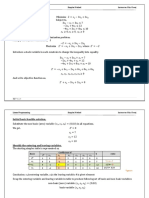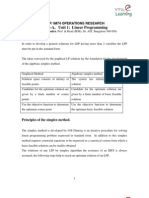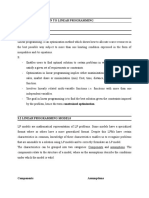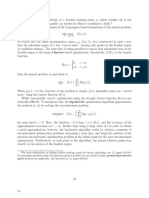Simplex Method
Uploaded by
Nakul AshokSimplex Method
Uploaded by
Nakul Ashok6s-1
Linear Programming
Simplex Method
Simplex: a linear-programming algorithm that can solve
problems having more than two decision variables. The simplex technique involves generating a series of solutions in tabular form, called tableaus. By inspecting the bottom row of each tableau, one can immediately tell if it represents the optimal solution. Each tableau corresponds to a corner point of the feasible solution space. The first tableau corresponds to the origin. Subsequent tableaus are developed by shifting to an adjacent corner point in the direction that yields the highest (smallest) rate of profit (cost). This process continues as long as a positive (negative) rate of profit (cost) exists.
6s-2
Linear Programming
Simplex Algorithm
The key solution concepts Solution Concept 1: the simplex method focuses on CPF solutions. Solution concept 2: the simplex method is an iterative algorithm (a systematic solution procedure that keeps repeating a fixed series of steps, called, an iteration, until a desired result has been obtained) with the following structure:
6s-3
Linear Programming
Simplex algorithm
Initialization: setup to start iterations, including finding an initial CPF solution Optimality test: is the current CPF solution optimal? if no Iteration: if yes stop Perform an iteration to find a better CFP solution
6s-4
Linear Programming
Simplex algorithm
Solution concept 3: whenever possible, the initialization of the simplex method chooses the origin point (all decision variables equal zero) to be the initial CPF solution. Solution concept 4: given a CPF solution, it is much quicker computationally to gather information about its adjacent CPF solutions than about other CPF solutions. Therefore, each time the simplex method performs an iteration to move from the current CPF solution to a better one, it always chooses a CPF solution that is adjacent to the current one.
6s-5
Linear Programming
Simplex algorithm
Solution concept 5: After the current CPF solution is identified, the simplex method examines each of the edges of the feasible region that emanate from this CPF solution. Each of these edges leads to an adjacent CPF solution at the other end, but the simplex method doesnt even take the time to solve for the adjacent CPF solution. Instead it simply identifies the rate of improvement in Z that would be obtained by moving along the edge. And then chooses to move along the one with largest positive rate of improvement.
6s-6
Linear Programming
Simplex algorithm
Solution
concept 6: A positive rate of improvement in Z implies that the adjacent CPF solution is better than the current one, whereas a negative rate of improvement in Z implies that the adjacent CPF solution is worse. Therefore, the optimality test consists simply of checking whether any of the edges give a positive rate of improvement in Z. if none do, then the current CPF solution is optimal.
6s-7
The simplex method in tabular form
Linear Programming
Steps: 1. Initialization: a. transform all the constraints to equality by introducing slack, surplus, and artificial variables as follows: Constraint type = Variable to be added + slack (s) - Surplus (s) + artificial (A) + Artificial (A)
6s-8
Linear Programming
Simplex method in tabular form
b. Construct the initial simplex tableau
Basic X1 variable
Xn S1
... Sn A1 . An
RHS
S
Coefficient of the constraints A Z Objective function coefficient In different signs
b1
bm Z value
6s-9
Linear Programming
Simplex method in tabular form
2. Test for optimality: Case 1: Maximization problem the current BF solution is optimal if every coefficient in the objective function row is nonnegative Case 2: Minimization problem the current BF solution is optimal if every coefficient in the objective function row is nonpositive
6s-10 Linear Programming
Simplex method in tabular form
3. Iteration Step 1: determine the entering basic variable by selecting the variable (automatically a nonbasic variable) with the most negative value (in case of maximization) or with the most positive (in case of minimization) in the last row (Z-row). Put a box around the column below this variable, and call it the pivot column
6s-11 Linear Programming
Simplex method in tabular form
Step 2: Determine the leaving basic variable by applying the minimum ratio test as following: 1. Pick out each coefficient in the pivot column that is strictly positive (>0) 2. Divide each of these coefficients into the right hand side entry for the same row 3. Identify the row that has the smallest of these ratios 4. The basic variable for that row is the leaving variable, so replace that variable by the entering variable in the basic variable column of the next simplex tableau. Put a box around this row and call it the pivot row
6s-12 Linear Programming
Simplex method in tabular form
1.
2.
3.
Step 3: Solve for the new BF solution by using elementary row operations (multiply or divide a row by a nonzero constant; add or subtract a multiple of one row to another row) to construct a new simplex tableau, and then return to the optimality test. The specific elementary row operations are: Divide the pivot row by the pivot number (the number in the intersection of the pivot row and pivot column) For each other row that has a negative coefficient in the pivot column, add to this row the product of the absolute value of this coefficient and the new pivot row. For each other row that has a positive coefficient in the pivot column, subtract from this row the product of the absolute value of this coefficient and the new pivot row.
6s-13 Linear Programming
Simplex method
Example (All constraints are ) Solve the following problem using the simplex method Maximize Z = 3X1+ 5X2 Subject to X1 4 2 X2 12 3X1 +2X2 18 X1 , X2 0
6s-14 Linear Programming
Simplex method
Solution Initialization 1. Standard form Maximize Z, Subject to
Z - 3X1- 5X2
X1 + S1
=0
= 4 2 X2 + S2 = 12 3X1 +2X2 + S3 = 18 X1 , X2, S1, S2, S3 0
Sometimes it is called the augmented form of the problem because the original form has been augmented by some supplementary variables needed to apply the simplex method
6s-15 Linear Programming
Definitions
1. 2.
3. 4.
5.
A basic solution is an augmented corner point solution. A basic solution has the following properties: Each variable is designated as either a nonbasic variable or a basic variable. The number of basic variables equals the number of functional constraints. Therefore, the number of nonbasic variables equals the total number of variables minus the number of functional constraints. The nonbasic variables are set equal to zero. The values of the basic variables are obtained as simultaneous solution of the system of equations (functional constraints in augmented form). The set of basic variables are called basis If the basic variables satisfy the nonnegativity constraints, the basic solution is a Basic Feasible (BF) solution.
6s-16 Linear Programming
Initial tableau
Entering variable
2. Initial tableau Basic variable S1 S2 S3 Z
Leaving variable
X1 1 0 3 -3
Pivot column
X2 0 2 2 -5
S1 1 0 0 0
S2 0 1 0 0
S3 0 0 1 0
Pivot row
RHS 4 12 18 0
Pivot number
6s-17 Linear Programming
Simplex tableau
Notes: The basic feasible solution at the initial tableau is (0, 0, 4, 12, 18) where: X1 = 0, X2 = 0, S1 = 4, S2 = 12, S3 = 18, and Z = 0 Where S1, S2, and S3 are basic variables X1 and X2 are nonbasic variables The solution at the initial tableau is associated to the origin point at which all the decision variables are zero.
6s-18 Linear Programming
Optimality test
By investigating the last row of the initial tableau, we find that there are some negative numbers. Therefore, the current solution is not optimal
6s-19 Linear Programming
Iteration
Step 1: Determine the entering variable by selecting the variable with the most negative in the last row. From the initial tableau, in the last row (Z row), the coefficient of X1 is -3 and the coefficient of X2 is -5; therefore, the most negative is -5. consequently, X2 is the entering variable. X2 is surrounded by a box and it is called the pivot column
6s-20 Linear Programming
Iteration
Step 2: Determining the leaving variable by using the minimum ratio test as following: Basic variable S1 S2 Leaving S3 Entering variable X2 (1) 0 2 2 RHS Ratio
(2) 4 12
18
(2)(1) None 6 Smallest ratio 9
6s-21 Linear Programming
Iteration
1.
Step 3: solving for the new BF solution by using the eliminatory row operations as following: New pivot row = old pivot row pivot number
Basic variable S1 X2 S3 Z
X1
X2
S1
S2
S3
RHS
1/2
Note that X2 becomes in the basic variables list instead of S2
6s-22 Linear Programming
iteration
2. For the other row apply this rule: New row = old row the coefficient of this row in the pivot column (new pivot row). For S1
1
0 (0 1 For S3 3 2 (0 3 for Z -3 -5(0 -3
0
1 0 2 1 0
1
0 1 0 0 0
0
1/2 0 0 1/2 -1
0
0 0 1 0 1
4
6) 4 18 6) 6
-5
1 0
0
0 0
0
1/2 5/2
0
0 0
0
6) 30
Substitute this values in the table
6s-23 Linear Programming
Iteration
X2 0 1 0 0 S1 1 0 0 0 S2 0 1/2 -1 5/2 S3 0 0 1 0 RHS 4 6 6 30
This solution is not optimal, since there is a negative numbers in the last row
Basic variable S1 X2 S3 Z
X1 1 0 3 -3
The most negative value; therefore, X1 is the entering variable
The smallest ratio is 6/3 =2; therefore, S3 is the leaving variable
6s-24 Linear Programming
Iteration
Apply the same rules we will obtain this solution:
Basic variable S1 X2 X1
Z
X1
0 0 1 0
X2
0 1 0 0
S1
1 0 0 0
S2
1/3 1/2 -1/3 3/2
S3
-1/3 0 1/3 1
RHS
2 6 2 36
This solution is optimal; since there is no negative solution in the last row: basic variables are X1 = 2, X2 = 6 and S1 = 2; the nonbasic variables are S2 = S3 = 0 Z = 36
6s-25 Linear Programming
Special cases of linear programming
Infeasible solution Multiple solution (infinitely many solution) Unbounded solution Degenerated solution
6s-26 Linear Programming
Notes on the Simplex tableau
1. In any Simplex tableau, the intersection of any basic variable with itself is always one and the rest of the column is zeroes. 2. In any simplex tableau, the objective function row (Z row) is always in terms of the nonbasic variables. This means that under any basic variable (in any tableau) there is a zero in the Z row. For the non basic there is no condition ( it can take any value in this row). 3. If there is a zero under one or more nonbasic variables in the last tableau (optimal solution tableau), then there is a multiple optimal solution. 4. When determining the leaving variable of any tableau, if there is no positive ratio (all the entries in the pivot column are negative and zeroes), then the solution is unbounded. 5. If there is a tie (more than one variables have the same most negative or positive) in determining the entering variable, choose any variable to be the entering one. 6. If there is a tie in determining the leaving variable, choose any one to be the leaving variable. In this case a zero will appear in RHS column; therefore, a cycle will occur, this means that the value of the objective function will be the same for several iterations. 7. A Solution that has a basic variable with zero value is called a degenerate solution. 8. If there is no Artificial variables in the problem, there is no room for infeasible solution
Simplex method incase of Artificial variables Big M method Solve the following linear programming problem by using the simplex method: Min Z =2 X1 + 3 X2 S.t. X 1 + X2 4 X1 + 3X2 20 X1 + X2 = 10 X1, X2 0
6s-27 Linear Programming
6s-28 Linear Programming
Big M method
Solution Step 1: standard form Min Z, s.t. Z 2 X1 3 X2 - M A1 -M A2 =0 X1 + X2 + S1 =4 X1 + 3X2 - S2 + A1 = 20 X1 + X2 + A2 = 10 X1, X2 ,S1, S2, A1, A2 0 Where: M is a very large number
6s-29 Linear Programming
Big M method
Notes M, a very large number, is used to ensure that the values of A1 and A2, , and An will be zero in the final (optimal) tableau as follows: 1. If the objective function is Minimization, then A1, A2, , and An must be added to the RHS of the objective function multiplied by a very large number (M). Example: if the objective function is Min Z = X1+2X2, then the obj. function should be Min Z = X1 + X2+ MA1 + MA2+ + MAn OR Z X1 - X2- MA1 - MA2- - MAn = 0 2. If the objective function is Maximization, then A1, A2, , and An must be subtracted from the RHS of the objective function multiplied by a very large number (M). Example: if the objective function is Max Z = X1+2X2, then the obj. function should be Max Z = X1 + X2- MA1 - MA2- - MAn OR Z - X1 - X2+ MA1 + MA2+ + MAn = 0 N.B.: When the Z is transformed to a zero equation, the signs are changed
6s-30 Linear Programming
Big M method
X2
3
Step 2: Initial tableau
Basic X1 variables 2 S1 A1 1
S1
0
S2
0
A1
M
A2
M
RHS 4 20
1 0
0 -1
0 1
0 0
A2
Z
1
-2
1
-3
0
0
0
0
0
-M
1
-M
10
0
Note that one of the simplex rules is violated, which is the basic variables A1, and A2 have a non zero value in the z row; therefore, this violation must be corrected before proceeding in the simplex algorithm as follows.
6s-31 Linear Programming
Big M method
To correct this violation before starting the simplex algorithm, the elementary row operations are used as follows:
New (Z row) = old (z row) M (A1 row) M (A2 row) In our case, it will be positive since M is negative in the Z row, as following: Old (Z row): -2 -3 0 0 -M -M 0 M (A1 row): M 3M 0 -M M o 20M M (A2 row): M M 0 0 0 M 10M New (Z row):2M-2 4M-3 0 -M 0 0 30M
It becomes zero
6s-32 Linear Programming
Big M method
X2
3
The initial tableau will be: S1
0
Basic X1 variables 2 S1 1/2 A1 A2 Z 1 1
2M-2
S2
0
A1
M
A2
M
RHS 4 20 10
30M
1/4 3 1
4M-3
1 0 0
0
0 -1 0
-M
0 1 0
0
0 0 1
0
Since there is a positive value in the last row, this solution is not optimal The entering variable is X2 (it has the most positive value in the last row) The leaving variable is A1 (it has the smallest ratio)
6s-33 Linear Programming
Big M method
X2 S 1
3 0
First iteration X1
2
Basic variables S1 X2
S2
0
A1
M
A2
M
RHS
7/3 20/3 10/3 20+10/3M
5/12 1/3 2/3 2/3M-1
0 1 0 0
1 0 0 0
1/12 -1/3 1/3 1/3M-1
-1/12 1/3 -1/3 1-4/3M
0 0 1 0
A2
Z
Since there is a positive value in the last row, this solution is not optimal The entering variable is X1 (it has the most positive value in the last row) The leaving variable is A2 (it has the smallest ratio)
6s-34 Linear Programming
Big M method
X2 S 1
0 1 0 0 1 0 0 0
Second iteration X1
0 0 1 0
Basic variables S1 X2 X1 Z
S2
-1/8 -1/2 1/2 -1/2
A1
1/8 1/2 -1/2 -M
A2
-5/8 -1/2 3/2 3/2-M
RHS
1/4 5 5 25
This solution is optimal, since there is no positive value in the last row. The optimal solution is: X1 = 5, X2 = 5, S1 = A1 = A2 = 0 and Z = 25
6s-35 Linear Programming
Note for the Big M method
In the final tableau, if one or more artificial variables (A1, A2, ) still basic and has a nonzero value, then the problem has an infeasible solution. All other notes are still valid in the Big M method.
6s-36 Linear Programming
Special cases
In the final tableau, if one or more artificial variables (A1, A2, ) still basic and has a nonzero value, then the problem has an infeasible solution If there is a zero under one or more nonbasic variables in the last tableau (optimal solution tableau), then there is a multiple optimal solution. When determining the leaving variable of any tableau, if there is no positive ratio (all the entries in the pivot column are negative and zeroes), then the solution is unbounded.
You might also like
- Topic 4 Transportation and Assignment Models - Chapter 950% (2)Topic 4 Transportation and Assignment Models - Chapter 964 pages
- Unit 2 Lecturer Notes of Linear Programming of or by DRNo ratings yetUnit 2 Lecturer Notes of Linear Programming of or by DR46 pages
- Chapter 02 Linear Programming Graphical MethodNo ratings yetChapter 02 Linear Programming Graphical Method13 pages
- Linear Programming - Model Formulation, Graphical Method100% (1)Linear Programming - Model Formulation, Graphical Method48 pages
- Chapter - 3: Linear Programming-Graphical SolutionNo ratings yetChapter - 3: Linear Programming-Graphical Solution14 pages
- Simplex Method of Maximization Problems Containing The Greater Than Symbol100% (1)Simplex Method of Maximization Problems Containing The Greater Than Symbol10 pages
- Mathematical Formulation of Linear Programming ProblemsNo ratings yetMathematical Formulation of Linear Programming Problems5 pages
- Chapter 2 (Part 1) Linear Programming (Formulation & Graphical Method)No ratings yetChapter 2 (Part 1) Linear Programming (Formulation & Graphical Method)47 pages
- Production Management A.) Economic Order Quantity Problems and SolutionsNo ratings yetProduction Management A.) Economic Order Quantity Problems and Solutions27 pages
- Introduction To Management Science: by Bernard W. Taylor IIINo ratings yetIntroduction To Management Science: by Bernard W. Taylor III50 pages
- Unit 3: Introduction To Linear ProgrammingNo ratings yetUnit 3: Introduction To Linear Programming12 pages
- Linear Programming Problems The Simplex Method: Dr. Siddhalingeshwar I.GNo ratings yetLinear Programming Problems The Simplex Method: Dr. Siddhalingeshwar I.G27 pages
- Linear Programming Problems and Solutions - SuperprofNo ratings yetLinear Programming Problems and Solutions - Superprof9 pages
- UNIT-1 1.1 Management Science and Quantitative AnalysisNo ratings yetUNIT-1 1.1 Management Science and Quantitative Analysis32 pages
- Operation Research 2 Dynamic ProgrammingNo ratings yetOperation Research 2 Dynamic Programming34 pages
- Practice Problem 3-2 - Minimization of Cost (Simplex Method)No ratings yetPractice Problem 3-2 - Minimization of Cost (Simplex Method)3 pages
- Simplex Method: Example (All Constraints Are )No ratings yetSimplex Method: Example (All Constraints Are )14 pages
- Non-Linear Optimization With Constraints and Extra ArgumentsNo ratings yetNon-Linear Optimization With Constraints and Extra Arguments4 pages
- Summary Notes On Maximization: KC BorderNo ratings yetSummary Notes On Maximization: KC Border20 pages
- LMS - Linear Programming (Simplex Method) ACC 421No ratings yetLMS - Linear Programming (Simplex Method) ACC 42190 pages
- Resource Management Techniques - Lecture Notes, Study Materials and Important Questions AnswersNo ratings yetResource Management Techniques - Lecture Notes, Study Materials and Important Questions Answers7 pages
- A New Branch and Bound Algorithm For Integer Quadratic Programming-2016No ratings yetA New Branch and Bound Algorithm For Integer Quadratic Programming-201612 pages
- Nonlinear Programming Solution TechniquesNo ratings yetNonlinear Programming Solution Techniques9 pages
- Adjoint Optimization: On State Constraint and Second Order Adjoint ComputationNo ratings yetAdjoint Optimization: On State Constraint and Second Order Adjoint Computation50 pages
- Sequencing Problems Processing N Jobs Through 2 Machines Problem Example PDF100% (1)Sequencing Problems Processing N Jobs Through 2 Machines Problem Example PDF2 pages
- 5 Performance - Remuneration (4,14,15,16)No ratings yet5 Performance - Remuneration (4,14,15,16)57 pages
- Topic 4 Transportation and Assignment Models - Chapter 9Topic 4 Transportation and Assignment Models - Chapter 9
- Unit 2 Lecturer Notes of Linear Programming of or by DRUnit 2 Lecturer Notes of Linear Programming of or by DR
- Linear Programming - Model Formulation, Graphical MethodLinear Programming - Model Formulation, Graphical Method
- Chapter - 3: Linear Programming-Graphical SolutionChapter - 3: Linear Programming-Graphical Solution
- Simplex Method of Maximization Problems Containing The Greater Than SymbolSimplex Method of Maximization Problems Containing The Greater Than Symbol
- Mathematical Formulation of Linear Programming ProblemsMathematical Formulation of Linear Programming Problems
- Chapter 2 (Part 1) Linear Programming (Formulation & Graphical Method)Chapter 2 (Part 1) Linear Programming (Formulation & Graphical Method)
- Production Management A.) Economic Order Quantity Problems and SolutionsProduction Management A.) Economic Order Quantity Problems and Solutions
- Introduction To Management Science: by Bernard W. Taylor IIIIntroduction To Management Science: by Bernard W. Taylor III
- Linear Programming Problems The Simplex Method: Dr. Siddhalingeshwar I.GLinear Programming Problems The Simplex Method: Dr. Siddhalingeshwar I.G
- Linear Programming Problems and Solutions - SuperprofLinear Programming Problems and Solutions - Superprof
- UNIT-1 1.1 Management Science and Quantitative AnalysisUNIT-1 1.1 Management Science and Quantitative Analysis
- Practice Problem 3-2 - Minimization of Cost (Simplex Method)Practice Problem 3-2 - Minimization of Cost (Simplex Method)
- Non-Linear Optimization With Constraints and Extra ArgumentsNon-Linear Optimization With Constraints and Extra Arguments
- Resource Management Techniques - Lecture Notes, Study Materials and Important Questions AnswersResource Management Techniques - Lecture Notes, Study Materials and Important Questions Answers
- A New Branch and Bound Algorithm For Integer Quadratic Programming-2016A New Branch and Bound Algorithm For Integer Quadratic Programming-2016
- Adjoint Optimization: On State Constraint and Second Order Adjoint ComputationAdjoint Optimization: On State Constraint and Second Order Adjoint Computation
- Sequencing Problems Processing N Jobs Through 2 Machines Problem Example PDFSequencing Problems Processing N Jobs Through 2 Machines Problem Example PDF

























































































